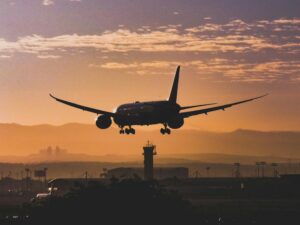A traveler booking flights between Lagos and London might pay significantly more than someone flying between Johannesburg and London, despite similar distances. This price disparity often prompts accusations of price gouging or discrimination against Nigerian travelers. The reality, however, reveals a complex interplay of economic factors, market dynamics, and infrastructure differences that explain why airline fares in Nigeria and South Africa cannot be the same.
Beyond Distance: The True Economics of Airline Pricing
Most passengers instinctively believe ticket prices should primarily reflect distance flown. This oversimplification misses the intricate cost structure that airlines must navigate.
Airlines operate with a mix of fixed and variable costs. Fixed costs include aircraft leasing, administrative salaries, office expenses, and insurance premiums. These expenses remain constant whether an aircraft flies once daily or five times. Variable costs fluctuate based on actual operations – fuel, maintenance, catering, and landing fees and route related charges.
The key to understanding pricing lies not just in these costs, but in how they’re distributed. An airline with three daily flights on a route spreads its fixed costs across more tickets than a carrier operating just three weekly flights.
“Each airline has its own unique cost structure, its own overheads, and its own revenue structure,” explains aviation economist Michael Johnson. “Even on identical routes, different carriers will calculate different breakeven points.”
A Tale of Two Aviation Markets
South Africa boasts a relatively mature aviation market with developed infrastructure. O.R. Tambo International Airport in Johannesburg and Cape Town International serve as regional hubs, attracting numerous international carriers and millions of passengers annually.
British Airways alone operates three daily flights to Johannesburg. This frequency allows the airline to spread fixed costs across more flights, enabling lower fares per seat. South Africa’s position as a tourism destination and business hub generates balanced traffic flows, optimizing aircraft utilization.
Nigeria’s aviation sector, while growing, faces different circumstances. Its airports handle fewer international flights, and its domestic network, though substantial, doesn’t benefit from the same economies of scale. Without the same level of competition in the market, pricing pressure remains lower, resulting in higher charges expected from airlines and passengers.
The South African aviation industry benefits from locally available maintenance facilities (MROs), training schools, and technical support services. Nigerian carriers must frequently send aircraft abroad for maintenance, training, and major repairs – adding significant costs that ultimately reflect in ticket prices.
Currency and Import Dependencies
Perhaps the most significant factor differentiating these markets is currency stability and import reliance.
Nigeria’s naira has experienced substantial devaluation against the dollar in recent years. This dramatically impacts airlines, as most aviation costs – from aircraft leases to spare parts to fuel – are either directly paid in dollars or priced according to dollar-based international standards.
South Africa, despite its own economic challenges, has maintained relatively more stability in the rand. This currency advantage becomes magnified across every aspect of airline operations.
Additionally, Nigeria imports virtually everything needed for aviation operations. South Africa, with its more developed manufacturing base and technical infrastructure, can source more supplies locally, reducing forex exposure.
When an airline must convert ever-more local currency to pay for the same dollar-denominated expenses, ticket prices inevitably rise.
The Supply-Demand Equation
Market forces fundamentally drive airline pricing. On routes with robust competition and multiple daily flights, airlines must price competitively. Routes with limited service or high demand relative to available seats command premium pricing.
Special events like international football matches dramatically illustrate this principle. When thousands of additional travelers suddenly need seats to a specific destination on specific dates, demand outstrips the available supply. Airlines respond with higher fares – not just in Nigeria but worldwide.
South Africa’s greater connectivity to global aviation networks – with flights from multiple UK airports daily to three South African cities – creates more competition and more seats, generally exerting downward pressure on prices.
Infrastructure and Operational Realities
Airport infrastructure significantly impacts airline costs. More efficient airports with modern navigation systems, adequate jetways, and streamlined ground operations reduce aircraft turnaround times and operating expenses.
South African airports generally offer more comprehensive facilities and services than their Nigerian counterparts. While Nigeria has made substantial investments in airport infrastructure, challenges remain in areas like power supply reliability, which sometimes necessitates the use of generators – adding costs that ultimately affect ticket prices.
Regulatory efficiency also differs between markets. Streamlined regulatory processes reduce compliance costs and administrative burdens for airlines. The relative regulatory efficiency in South Africa compared to more complex compliance requirements in Nigeria represents another cost differential that manifests in pricing.
Looking Beyond Simple Comparisons
The pricing differences between Nigerian and South African air travel reflect fundamental economic and operational realities rather than arbitrary discrimination. Understanding these factors helps contextualize fare disparities that might otherwise seem unfair.
As Nigeria continues developing its aviation infrastructure and economy, some of these gaps may narrow. Ongoing investments in airports, potential currency stabilization, and increasing flight frequencies could eventually create more favorable conditions for competitive pricing.
Until then, the price difference between a Lagos-London and Johannesburg-London ticket will remain – not because of geography alone, but because of the complex ecosystem in which each market operates.
For travelers, this understanding might not make higher fares more palatable, but it places them in a broader economic context that extends far beyond the simple distance between departure and arrival gates.
Disclaimer: The insights shared in this article are for information purposes only and do not constitute strategic advice. Aviation markets and circumstances vary, and decisions should be based on your organisation’s specific context. For tailored consultancy and guidance, please contact info@avaerocapital.com.




